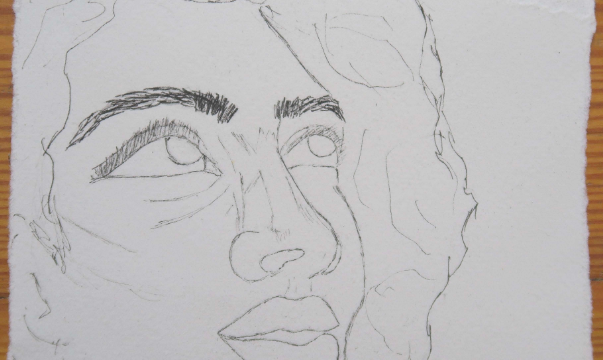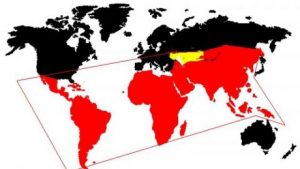
GAIA RISING
GAIA RISING
Kate Roger
Artist Statement
As an artist, I like to work with a lot of different forms, and particularly like to mix forms and disciplines. I primarily work with drawing and painting, but also enjoy photograph and mixed media work. I have dabbled in installation a bit, and really thrive on making experimental and experiential work. I have a particular interest in mapping and in constellatory work, in deconstructing linear narratives and notions of objecthood.
My work is driven by a radical femme sensibility and a desire to use art as a tool for poetic futurism— reading Poetry is Not a Luxury reminds me every day why I do work. I am interested in stories of women, of queer folx, of love and loving through new ecologies. Content-wise, I like to work with the quotidian as magic— how is magic the unseen backdrop of our every day lives? I think, here, I am influenced by Latin American magical realists like Borges and Marquez. I want to make political work that can help us imagine new ways of becoming and being— which means creating narratives of the past and present that open up new futures.
So far, I have noticed a an aesthetic trend in my work toward a sort of minimalism— I really like to use negative space. And, I don’t know why, but I’ve always loved the look of unfinished work. I don’t like to fill in all the spaces, all the lines. I like to leave some room for possibility. I definitely like to work with more sparse and muted color palettes— this feels like balance to me.
I like pastels, and find watercolor, or just pen and ink, a really lovely medium for the kind of density I like in my work.
I think I have spent a lot of time in the past couple years thinking about how my whiteness affects my writing and my artwork. What does it mean to make work that strives toward justice, while at the same time recognizing my own whiteness? How can I write stories about lives unlike mine without falling to appropriation and othering? I want the characters that people my work to be complex human beings, to be queer and Black and Korean and Chicana, royalty and low-income, middle class white people from Kansas, engineers, poets, vampires, witches, computer whizzes from Nigeria, genderqueer dancers from Taiwan. I don’t want to only write my own story— and, of course, I only really can write my own story. That’s the only one my body knows. And I fully believe in writing from the body. So, I think I grapple with all of these things in my work— and haven’t figured out any answers! And doubt I will.
My interest in performance studies absolutely informs my work. To me, performance studies is an effective methodology for the work of healing and creating new futures. It is a way of reorienting our epistemologies and histories in order to create a more loving present, and future. It is a mode of centering the body, centering affect and discrete phenomena, and of undoing patriarchal, logocentric, imperialist ways of knowing. I know my work is heavily influenced by film and theater, but particularly film. My writing and painting often reflect a cinematic impulse. I have a soft spot for artsy indie films, and that shows up in my work.
Title and Brief Description
Title: Gaia Rising
Description:
My project is an origin myth based in the the creation story of Western science. It aims to explore the cosmology (and beauty, and metaphor) inherent to supposedly objective Western science. The story centers around Sol, the sun, and her daughter, Gaia, the earth. The narrative follows Gaia’s evolution from self-replicating RNA to a new species of human, Homo haelan. The ideas within the story are drawn from geology, queer-of-color writers, indigenous scholars, poststructuralism, Buddhist ecology, and queer materialism.
Notes on Craft
Main themes:
- Motherhood
- Loneliness and death
- Ecology
- Science and cosmology
- Buddhist enlightenment and no-self
- Evolution
- Human pride/exceptionalism
Visual Representation
I used pen and ink on Bristol for this project. I decided to present the project as a de- colonial version (or a play on) a Natural History exhibit. One of those “evolution-through-the- ages” type things. I really like the affective experience of moving through history. It feels sacred, and I think it combines the cosmology and the science of this project in a very particular way, and allows me to use multiple mediums.
Challenges
I think my main challenges will be: access to materials and biting off more than I can chew. I tend to have grand plans that aren’t always realizable (and then I exhaust myself trying to realize them). And, I don’t have access to a lot of materials. I can steal stuff from the art building, but I don’t know… I might ask someone if I can use the studios.
14
(359-252 million years ago) Gaia came back, angry, but steady and sure, too, and more plentiful than ever. She became reptiles, therapsids (mammal ancestors!), and all kinds of terrestrial plant communities. She became Tiktaalik, a funny little transitional creature, as she made her way from land to sea, shed fins for feet.
Works Cited
*Most of the content for this project came from my class notes from Professor Phoebe Cohen’s Geos 101 class: Coevolution of Earth and Life
Anderson, Natali. “Paleontologists Unearth Tropical Fossil Forests in Norway.” Sci News, 19 November 2015, http://www.sci-news.com/paleontology/tropical-fossil-forests-svalbard-norway-03449.html.
Berwyn, Bob, et al. “Global CO2 Emissions to Hit Record High in 2017.” InsideClimate News, InsideClimate News, 6 Nov. 2018, insideclimatenews.org/news/12112017/climate-change-carbon-co2-emissions-record-high-2017-cop23.
Channel, Chemistry. “How Were the Oceans Formed.” YouTube, YouTube, 20 July 2017, www.youtube.com/watch?v=fDYt3ohbcio.
Choi, Charles Q. “Earth’s Sun: Facts About the Sun’s Age, Size and History.” Space.com, Space.com, 8 June 2018, www.space.com/58-the-sun-formation-facts-and-characteristics.html.
“Climate Change News, Pictures, Research and Theories.” Express.co.uk, Express.co.uk, www.express.co.uk/latest/climate-change.
Dunbar, Brian. “Historical Aspects of Our Sun.” NASA, NASA, www.nasa.gov/vision/universe/solarsystem/sun_history.html.
Erastova, Valentina, et al. “Mineral Surface Chemistry Control for Origin of Prebiotic Peptides.” Nature News, Nature Publishing Group, 11 Dec. 2017, www.nature.com/articles/s41467-017-02248-y.
Feldman, Kate. “California Wildfires Have Released Emissions Equal to about 68 Million Tons of Carbon Dioxide This Year – NY Daily News.” Nydailynews.com, New York Daily News, 3 Dec. 2018, www.nydailynews.com/news/national/ny-news-california-wildfires-carbon-emissions-20181202-story.html.
Hazen, R. M. The Story of the Earth: The First 4.5 Billion Years, from Stardust to Living Planet; New York, 2013.
Hill, Helen. “Determining the Timing of Methanogen Evolution.” MIT News, 4 Apr. 2018, news.mit.edu/2018/mit-researchers-determine-timing-of-methanogen-evolution-0404.
“How Cyanobacteria Could Help Save the Planet.” Singularity Hub, Singularity Hub, 11 June 2018, singularityhub.com/2018/06/04/how-cyanobacteria-could-help-save-the-planet/#sm.0001viehvmcjzdzjxa12cxprzle8n.
“Kuu Syntyy.” Aikavaellus, aikavaellus.fi/aikamatka/4530/.
Masterson, Andrew. “Bleach clue in origin of life hunt.” Cosmos Magazine. 13 November 2017. https://cosmosmagazine.com/biology/bleach-clue-in-origin-of-life-hunt
“The Paradox of a Weak Young Sun.” Earth Chronicles News, earth-chronicles.com/space/the- paradox-of-a-weak-young-sun.html.
“Planet Formation and the Origin of Life.” The Planetary Society Blog, www.planetary.org/blogs/guest-blogs/dante-lauretta/20150209-planet-formation-origin-life.html.
Russell, S. S.; The Formation of the Solar System. Journal of the Geological Society ; 164 (3): 481–492. doi: https://doi.org/10.1144/0016-76492006-054
Sheppard, Ciara. “These Photos of Black Girls Rocking Their Natural Hair Are Seriously Awesome.” Glamour, Glamour UK, 4 Jan. 2018, www.glamourmagazine.co.uk/article/portraits-of-black-girls-rocking-natural-hair.
Stock, J. T; Are humans still evolving? EMBO Rep. 2008;9 Suppl 1(Suppl 1):S51-4. https://www.ncbi.nlm.nih.gov/pmc/articles/PMC3327538/
“Sun.” NASA, NASA, 30 Nov. 2018, solarsystem.nasa.gov/solar-system/sun/overview/#introduction_otp.
“The Sun.” Nine Planets, nineplanets.org/sol.html.
“The Weekly.” The Weekly RSS, theweekly.co.za/?p=20868.
MORE WORK BY KATE ROGER
Related Images:
no images were found
